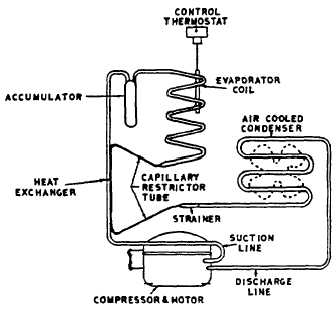CHAPTER I
SEC II
SECTION II - EXPLANATION OF THE REFRIGERATION SYSTEM
SCHEMATIC - REFRIGERATION
When the temperature of the water in the cooler rises
above a predetermined level, contacts of the controlling
thermostat close, causing the refrigeration compressor
and condenser fan motor to start. As the refrigerant
passes through the system a change of state results. It
leaves the compress- or as a hot high pressure vapor
and passes through
the condenser where it is converted to a high pressure
liquid by the removal of heat. The refrigerant then
passes through the strainer and capillary restrictor tube
into the evaporator as a low pressure liquid. In the
evaporator, the refrigerant begins to boil as a cold low
pressure vapor. The compressor suction removes this
vapor and compresses it to a hot high pressure vapor
and the start of a new cycle.
When the desired temperature is attained, the
contacts of the controlling thermostat open causing the
compressor and fan motor to stop. The refrigerant
continues to flow from the condenser, through the
strainer and capillary restrictor tube to the evaporator
due to the pressure differences in the system. This
action will continue until the pressures equalize.
The refrigerant has a tendency to collect and
condense at the coldest part of the system while the
compressor is off. Therefore an accumulator is used to
trap the excess liquid refrigerant. When the compressor
starts, it becomes necessary to draw off the refrigerant
from the accumulator as a vapor, compress and
condense it before cooling can resume.
The refrigeration system of the water cooler is
hermetically
sealed
and
critically
charged
with
refrigerant. Too much or too little refrigerant is
detrimental to the operation. The system has been
dried to a high degree, 10 PPM (Parts Per .Million).
Under normal conditions the refrigeration system should
not be disturbed.
4

